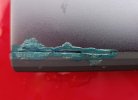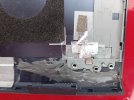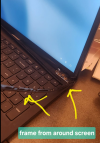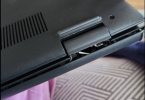britechguy
Well-Known Member
- Reaction score
- 5,069
- Location
- Staunton, VA
Just thought I'd post this here for the sake of education and perverse amusement. The client for whom I am trying to find a replacement laptop had a Dell Inspiron from 2020 and it's right hinge detached from the lid and before she realized what was happening it put so much pressure on the screen that it fractured. In looking at even trying to source full screen assemblies it became obvious to me that we were in "uneconomical to fix" territory. When that happens, though, I often end up taking the equipment for recycling, and sometimes I decide to play with taking things apart and potentially fixing because I can (even though it would have cost way too much for the client to pay me to do it). I decided to go this route with this laptop since it has a Ryzen 7 processor and can run Windows 11. All my other "backup laptops" are so old that they are not supported hardware for Windows 11.
Here's what I found:
Right side of the lid, where the metal plate that the hinge screws into has come off, with collateral damage:
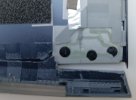
Notice that this plate was affixed to the lid with the thinnest of lines of glue, and not very strong glue at that. It's clearly visible.
Now, for the plate itself, the side that faced the glue:
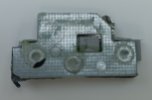
You can see just how little of the surface area of the plate itself had glue applied and affixing it to the lid. The side where the hinge would screw into:
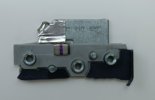
This plate has been reaffixed to the lid with Harbor Freight Welder Epoxy that's now curing for 24 hours as I type. That should hold it in place much more firmly than that silly line of whatever glue was used originally.
Here's the other side of the lid, with the hinge in place, but where I've removed the screws (very wide heads to distribute force) so you could see the arrangement a bit better:
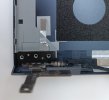
Notice tha the piece of aluminum grounding tape is split, and that's because that plate is in the process of doing precisely what the one on the right side had already done. Since it was still quite firmly affixed on the whole, I just ran superglue under the edges figuring that once that sets up that side should then be pretty darned firmly affixed, too.
Given how stiff the hinge mechanisms are, and must be if you want the lid to stay in the position it's opened to, how these things are affixed to the lid is just criminally stupid. The lid itself did not break, but once that plate separates from the lid because of inadequate gluing, it's all over, including for the screen which will end up breaking fairly soon after (if the lid keeps being opened and closed).
Why the screws that hold the lid to the plate don't continue through to the lid itself to hold all together, with the glue acting as a supplement, I'll never know. If you're not going to do that, then for the love of heaven use a glue type, and amount, that ensures that the plate is never coming off that lid.
This kind of half-assed design is just so certain to fail that I cannot believe that any manufacturer would use it!
Once I have the lid and hinges fixed, then I'll set about finding a replacement screen when I feel like it.
Here's what I found:
Right side of the lid, where the metal plate that the hinge screws into has come off, with collateral damage:

Notice that this plate was affixed to the lid with the thinnest of lines of glue, and not very strong glue at that. It's clearly visible.
Now, for the plate itself, the side that faced the glue:

You can see just how little of the surface area of the plate itself had glue applied and affixing it to the lid. The side where the hinge would screw into:

This plate has been reaffixed to the lid with Harbor Freight Welder Epoxy that's now curing for 24 hours as I type. That should hold it in place much more firmly than that silly line of whatever glue was used originally.
Here's the other side of the lid, with the hinge in place, but where I've removed the screws (very wide heads to distribute force) so you could see the arrangement a bit better:

Notice tha the piece of aluminum grounding tape is split, and that's because that plate is in the process of doing precisely what the one on the right side had already done. Since it was still quite firmly affixed on the whole, I just ran superglue under the edges figuring that once that sets up that side should then be pretty darned firmly affixed, too.
Given how stiff the hinge mechanisms are, and must be if you want the lid to stay in the position it's opened to, how these things are affixed to the lid is just criminally stupid. The lid itself did not break, but once that plate separates from the lid because of inadequate gluing, it's all over, including for the screen which will end up breaking fairly soon after (if the lid keeps being opened and closed).
Why the screws that hold the lid to the plate don't continue through to the lid itself to hold all together, with the glue acting as a supplement, I'll never know. If you're not going to do that, then for the love of heaven use a glue type, and amount, that ensures that the plate is never coming off that lid.
This kind of half-assed design is just so certain to fail that I cannot believe that any manufacturer would use it!
Once I have the lid and hinges fixed, then I'll set about finding a replacement screen when I feel like it.


